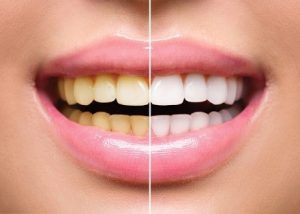Why Do Teeth Go Yellow?
A number of different things can affect the colour of your teeth, turning them that unbecoming shade of yellow. Most causes of tooth discolouration fall into one of two categories: extrinsic stains or intrinsic stains. However, your teeth can also turn yellow with advancing age or be related to your genes. Let’s explore the different causes of tooth discolouration and what you can do to prevent yellow teeth.

Extrinsic stains
This when the enamel (the outer layer of the tooth) is stained. Dark-coloured beverages such as coffee, tea, red wine, and coca cola as well as dark-coloured foods such as blueberries and pomegranates, also have the potential to stain teeth. These foods and drinks are high in pigment-producing substances called chromogens which tend to stick to tooth enamel. Acidic foods and beverages can cause further problems because they erode tooth enamel and make it easier for chromogens to latch onto your teeth.
Smoking and chewing tobacco can also cause extrinsic stains.
Intrinsic stains
This is when the dentin (the inner structure of the tooth) darkens or turns yellow. This type of discoloration can potentially be caused by an event or exposure to a number of substances including:
- fluoride (during early childhood) – fluorosis, the yellowing of teeth from too much fluoride, is a problem which is presents itself mostly in areas where the drinking water contains high levels of naturally occurring fluoride. Excessive use of fluoride applications, rinses, toothpaste, and fluoride supplements can also cause tooth discolouration.
- antibiotics such as tetracycline and doxycycline – this medication is known to cause discolouration of teeth when given to children whose teeth are still developing (before age 8).
- certain antihistamines, antipsychotic drugs, and drugs for high blood pressure
- chlorhexidine, an antiseptic contained in certain mouth washes and rinses
- the acne-fighting drug minocycline
- chemotherapy and/or radiation used to treat cancer and chemotherapy drugs
- trauma (such as a fall) that resulted in damage to a tooth when you were a young child
- trauma in a permanent tooth, and internal bleeding resulted in tooth discolouration
- a rare condition called dentinogenesis imperfecta which causes grey, amber or purple discolourations
- dental treatments – some dental materials can cause discolouration, such as amalgam restorations, especially silver sulfide-containing materials, can cause grey-black discolouration
Your Age
This is a combination of both extrinsic and intrinsic factors. Dentin naturally yellows over time. Meanwhile, the outer layer of enamel on our teeth gets thinner as you age, revealing the natural yellow colour of dentin.
Your Genes
Some people are born with naturally brighter or thicker enamel than others. If you have thin enamel, the colour of your naturally yellowish dentin will show through.
Prevention
The best ways to prevent your teeth from going yellow are to watch what you eat and practice good dental hygiene. You will be able to prevent some stains by brushing your teeth after every meal. Plaque and tartar build-up looks yellow. Removing that build-up before decay sets in is very important for oral hygiene and aids with prevention of tooth discolouration. Regular visits to the dentist will also help to prevent and remove discolouration (professional cleaning can be done). You also can purchase whitening and stain removal products to use at home.
In some cases intrinsic stains that are caused by damage to a nerve or blood vessel in a tooth can be prevented. You may be able to have root canal treatment to remove the inner part of the tooth before decay and discolouration occurs.
Early exposure to high levels of flouride should be avoided in order to prevent intrinsic stains in children. Once the enamel is formed, fluoride will not result in tooth discolouration.
Eden Rise Dental offers professional teeth cleaning services at our Berwick Dental Clinic. Our dentists can advise you on the best treatment for your tooth discolouration problem or evaluate any change to your child’s tooth colour.
